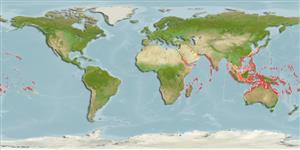Common names from other countries
Environment: milieu / climate zone / depth range / distribution range
Écologie
marin récifal; profondeur 0 - 35 m (Ref. 37816), usually 5 - 35 m (Ref. 27115). Tropical; 24°C - 27°C (Ref. 27115); 35°N - 36°S, 28°E - 124°W
Indo-Pacific: Red Sea and East Africa (Ref. 5469) to the Hawaiian, Line, Marquesan and Ducie islands, north to southern Japan, south to New Caledonia and the Austral Islands. Unknown from the Persian and Oman gulfs (Ref. 11441).
Taille / Poids / Âge
Maturity: Lm ? range ? - ? cm
Max length : 22.0 cm TL mâle / non sexé; (Ref. 30573); common length : 18.0 cm TL mâle / non sexé; (Ref. 30573)
Épines dorsales (Total) : 10; Rayons mous dorsaux (Total) : 11; Épines anales: 3; Rayons mous anaux: 6. Body yellowish with broad blackish stripe on upper side; head and anterior part of body with small dark reddish spots (Ref. 5469).Color changes with growth as well as varies among adults (Ref. 37816). In Oceania, juveniles are a golden green dorsally and white ventrally; in continental areas juveniles may be red dorsally (Ref. 37816). The maroon and yellow phase was originally described as a distinct species, P. typee (Ref. 37816).
Inhabits clear lagoon or seaward reefs to at least 33 m depth (Ref. 9710), but may venture very deep. Occurs openly on coral and soft-bottom habitats, occasionally in pairs (Ref. 48636). Benthic (Ref. 58302). Tends to perch on outermost branches of Stylophora, Pocillopora, and Acropora corals (Ref. 9710). Feeds mainly on small fishes and crustaceans, sometimes on shrimps and is territorial and haremic (Ref. 37816). Solitary on corals (Ref 90102). Marketed mostly fresh. Minimum depth reported taken from Ref. 128797.
Life cycle and mating behavior
Maturities | Reproduction | Spawnings | Egg(s) | Fecundities | Larves
Distinct pairing. Spawning ascents into the water column occurred over a distance of 1.0 to 2.5 m (Ref. 26305).
Randall, J.E., G.R. Allen and R.C. Steene, 1990. Fishes of the Great Barrier Reef and Coral Sea. University of Hawaii Press, Honolulu, Hawaii. 506 p. (Ref. 2334)
Statut dans la liste rouge de l'IUCN (Ref. 130435)
CITES (Ref. 128078)
Not Evaluated
Menace pour l'homme
Harmless
Utilisations par l'homme
Can't connect to MySQL database (fbapp). Errorcode: Too many connections
